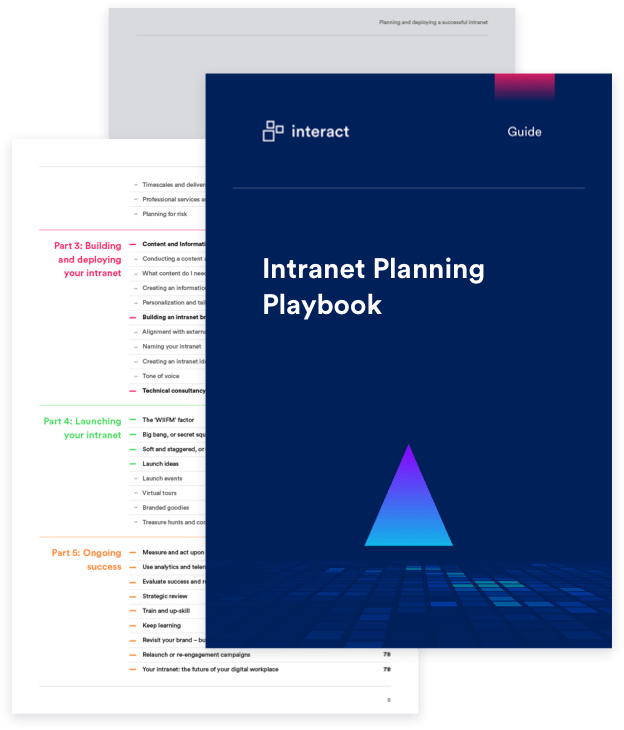Driving intranet adoption: 16 top tips to get users on board

Rolling out a new intranet is a significant change communication project. Unless employees understand when, why, and how they will use the new platform, intranet adoption and engagement will be low. Make your change project a strategic success with these tips to increase intranet adoption from the outset.
One of the greatest challenges of introducing a new platform, process, or business change is ensuring that employees are aware and engaged.
Without a comprehensive communication and launch plan, there is a greater risk of project failure. This is particularly true for digital transformation projects where software adoption is a driving factor in long-term success.
This challenge has proved so significant for the consultancy firm PwC that it is investing $1 billion in helping its workforce adopt new generative AI tools.
According to one report, PwC has “some 1500 employees it calls activators embedded across the firm whose job includes helping with change management efforts—sharing benefits of the new technologies or encouraging its use.”
You may not have a billion dollars hanging over your new intranet, but you will still be under pressure to justify the investment in your project. If so, getting employees to log on and potentially change their long-standing behaviors (e.g., if people are used to sending all communications via email rather than posting on the intranet) is fundamental.
The tips below will help you formulate a change communications plan and intranet engagement strategy to change employee behavior and drive intranet adoption sky-high.
- #1: Get employees involved during development
- #2: Plan a launch that reaches everyone
- #3: Improve accessibility with an intranet app
- #4: Be clear about the business challenges
- #5: Provide training and “how-to” guidance
- #6: Make the intranet the “go-to” place for business news and content
- #7: Centralize business-critical workflows
- #8: Ask the C-Suite to set a good example
- #9: Plan regular rollouts for increased intranet adoption
- #10: Set out the “where, what, and why” for your intranet vs. other applications
- #11: Make it the default homepage on web browsers
- #12: Give it a personality
- #13: Don’t make it “all business”
- #14: Social tools that drive intranet adoption
- #15: Introduce employee recognition and rewards
- #16: Personalize internal communication
- Software adoption as a change management project isn’t a one-off event
Must-Read Intranet Playbook
#1: Get employees involved during development
If you’re in the planning or early implementation phases of an intranet rollout, one of the most powerful software adoption tools at your disposal is working with employees. Gathering opinions and user feedback can ultimately improve the platform and be more impactful than imposing change from above.
You may want to involve small groups or individuals in design decisions. Some organizations roll out a prototype version of the new platform (sometimes called a Minimum Viable Product) to subsets of employees to test usability and gain valuable feedback.
When people are aware of an upcoming change or have had a chance to participate, they’re more likely to understand the value of your intranet and be invested in its use and success.
Research suggests that when people are invested in change it is 30% more likely to work over the long term. This is essential for increasing intranet adoption and engagement.

#2: Plan a launch that reaches everyone
Although the exact details will depend on your organization and intranet objectives, planning a multi-stage, multi-activity intranet launch campaign can generate engagement and embed change.
Intranet launch ideas range from “teaser” emails and videos to naming competitions and intranet treasure hunts.
Anything that raises intrigue and gets people using the platform will ensure that people feel informed rather than imposed upon.
Driving intranet adoption through a change or launch campaign isn’t solely for the first time a change happens.
The UK housing association Curo did a small-scale relaunch to drive the adoption of the intranet’s refreshed brand, content, and structure.
We stayed late one evening and laid out treats on all the desks, as well as posting some out in advance to all our dispersed offices. With them, we gave staff a card that outlined what had changed. It went down really well: people were getting straight on to look at it when they came in. Since the relaunch, we’ve seen a real push on the more interactive features and in particular the blogs and our rewards.
– Communications Officer, Curo
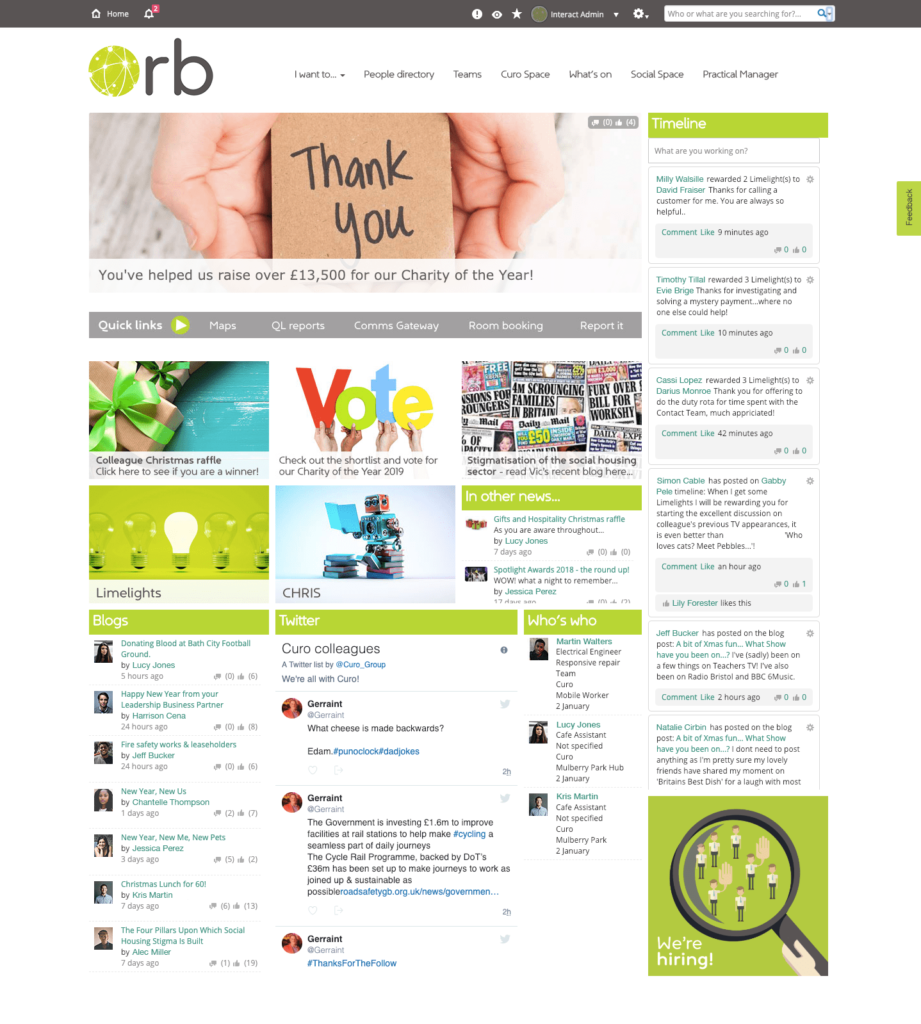
#3: Improve accessibility with an intranet app
If there’s one thing that interrupts communication, slows change, and halts software adoption, it’s poor accessibility.
Many people within your workforce, especially desk-less and frontline workers, do not have access to desktop computers or corporate email, yet they still require the same level of information and encouragement that desk-based employees receive.
An intranet mobile app can improve change communications and broaden your intranet engagement strategy. Employees in retail stores or warehouses can easily access resources and receive comms updates.
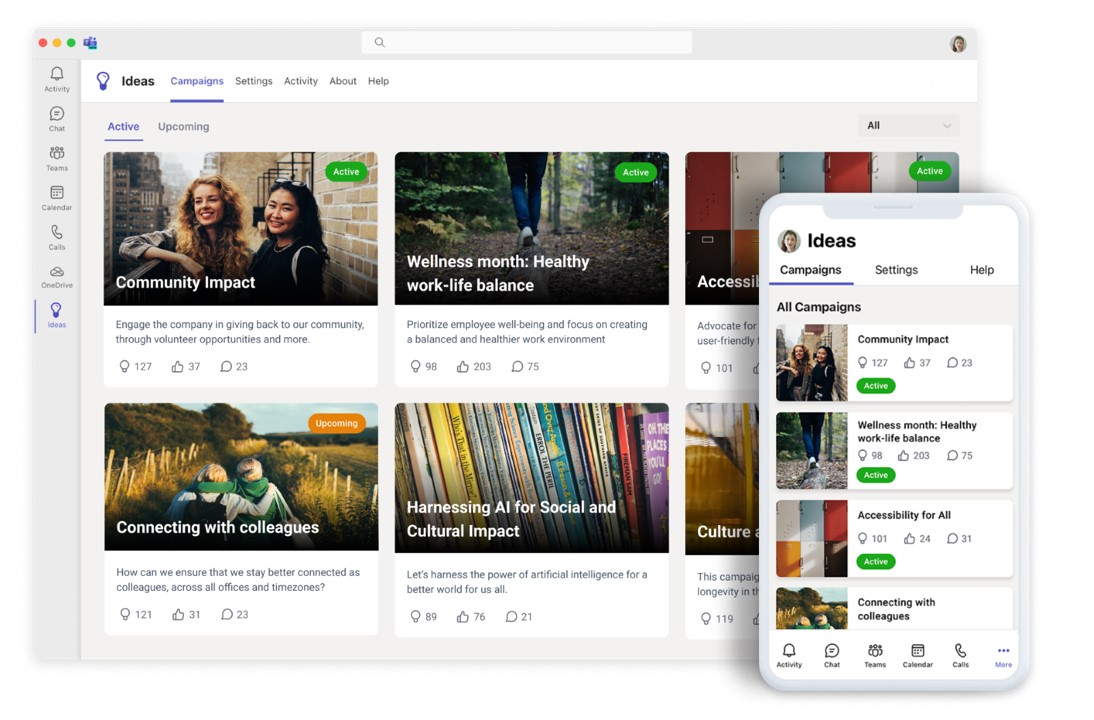
#4: Be clear about the business challenges
Change takes hold when people understand the value of the project. After all, how can you expect employees to understand the need for a new intranet if you don’t fully understand it as a central stakeholder?
Defining your intranet’s purpose for the company is a starting point, but you can go further.
During the planning phase, organize user journeys and requirements by team so that you have an understanding of what each audience is using the intranet for. Mapping team objectives provides a clearer sense of what different people are lacking and how to construct a platform and a comms plan that will address their needs.

If your internal research shows that the marketing team uses the intranet for storing brand materials and promoting campaigns via social advocacy, your comms and training plan should address how to make that more impactful. This focus will drive intranet adoption across different audiences.
Must-Read Intranet Playbook
#5: Provide training and “how-to” guidance
Lack of confidence is a major software adoption killer. If employees don’t understand how to use your intranet, they’ll quickly fall away.
Most organizations deliver training as part of the launch process; our advice is to continue beyond this first flush of activity.
Make an introduction to the intranet part of the onboarding process for new recruits, and hold regular refresher sessions for different teams when the need arises.
How can you tell which teams require more training? Intranet analytics should reveal which departments have or have not been visiting key content (e.g., HR policies or change communications). Understanding who is missing from your audience is the first step in deciding whether increased training, access, or awareness will help to increase adoption.
#6: Make the intranet the “go-to” place for business news and content
Effective organizations have a multichannel internal communications strategy with the intranet as the central knowledge base.
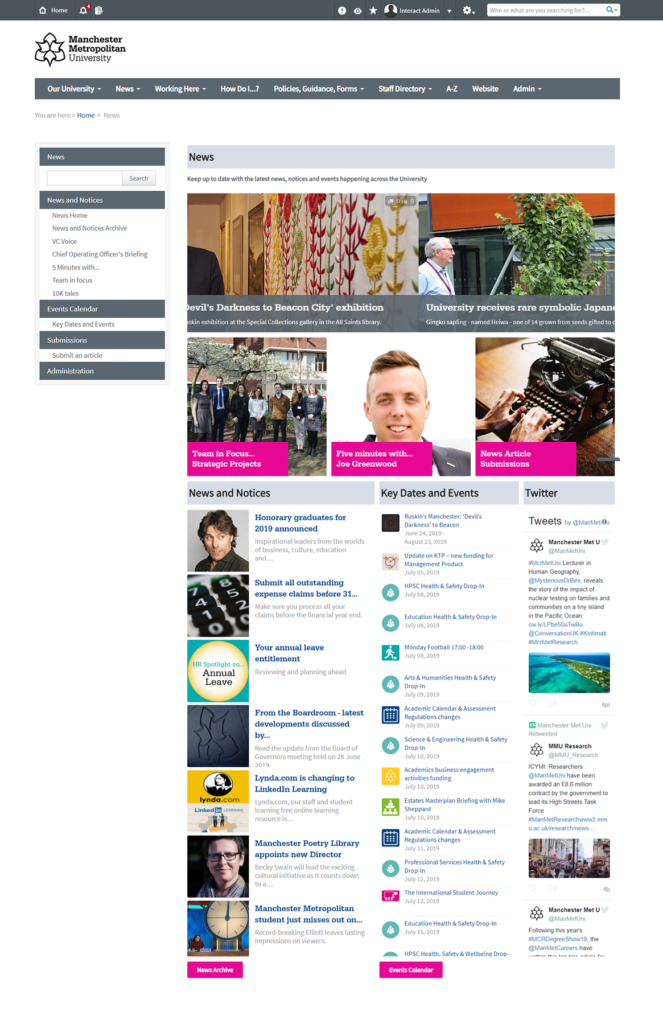
Emails, digital signage, Teams notifications – or the other channels that work best for the workforce – should include a short alert and headline that draws employees to the intranet for the full story.
One of the main advantages of this is that the main content page is easily updated and monitored on the intranet, so all the comms team needs to do is deliver short multichannel notifications that “pull” employees to learn more rather than having to write or rewrite the same lengthy emails each time.
#7: Centralize business-critical workflows
Build the intranet as a “front door” to line of business applications and daily processes – such as booking PTO or submitting expenses – and you give users a concrete and essential reason to use it.
During the planning phase, ask the different departments and communities in the organization what are the most common tasks and applications in use. Perhaps some processes are still paper-based but could be done faster through the intranet.
Selling the value of streamlined, simplified, and faster digital processes can help get both users and managers on board.
The US multimedia and entertainment company Audacy uses its intranet as a central hub for the entire digital workplace.

Each time users visit the site to access something important, they find new updates, culture initiatives, and other communications that connect them and strengthen the brand too.
#8: Ask the C-Suite to set a good example
Senior leaders often set the tone for an organization, making them critical for software adoption and the success of any change management project.
However, in large enterprises especially, many employees have little chance to interact with, or even see, senior management, so they may have no awareness of the importance of intranet adoption and behavioral change. The intranet is an ideal platform to give management a face, voice, and means for communicating their vision. This could be through regular blogs or vlogs, for example.
Don’t underestimate the value and power of simple likes, shares, or comments. When people see those at the top being involved or engaging with them, it incentivizes everyone to follow suit.
CEO of the Federation for Small Businesses (FSB), Julie Lillie, was instrumental in driving intranet adoption. Her comments, likes, and shares were a way of endorsing and promoting the intranet as a critical tool across the organization.
In FSB’s internal communications survey, employees highlighted the CEO’s activity on the platform as a driver of success.
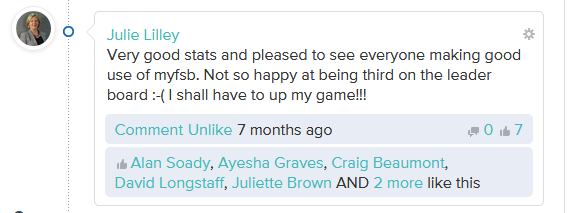
#9: Plan regular rollouts for increased intranet adoption
A modern intranet solution is a highly sophisticated platform with a wide range of features and functionality.
Rather than introducing everything all at once, effective change management strategies typically build software adoption over time with the staggered rollout of features to different audiences.
This best practice approach increases awareness and training over time so that everyone understands the depth of the software without feeling overwhelmed.
Start with the core menu items and pieces of content that audiences need to understand, and eventually build to more advanced functionality such as generative AI tools for intranet content creation.
Must-Read Intranet Playbook
#10: Set out the “where, what, and why” for your intranet vs. other applications
From systems of record to productivity suites like Microsoft 365, large enterprises now have over 200 different applications within their digital estates.
If the addition or replacement of an intranet isn’t planned and communicated as a change management priority, it may become part of this enterprise noise. Low adoption rates for an intranet are often caused by a lack of understanding about why or when it should be used in place of other tools.
Spelling out the use cases and benefits of an intranet for users will help.
Regardless of the other platforms in use, what employees should know about the intranet is that it is the organization’s center and the place to find what they need to know about the company. For accessing company news, giving peer recognition, checking policies, or even getting access to other apps (through integrations), the intranet is the first digital port of call.
#11: Make it the default homepage on web browsers
Simple and highly effective, setting the intranet as the default homepage so it’s the first thing employees see when firing up their laptops ensures it remains front-of-mind.
#12: Give it a personality
Very few people will be incentivized to visit a dry corporate platform populated only with policies.
A modern intranet, however, should be a digital version of your workplace: one that communicates company values and culture through design and content.
Inject life into it by giving it a brand, a theme, an intranet name, and a logo. Creating a platform that’s visually appealing and fun to experience is a proven way to drive greater intranet adoption and achieve successful change.
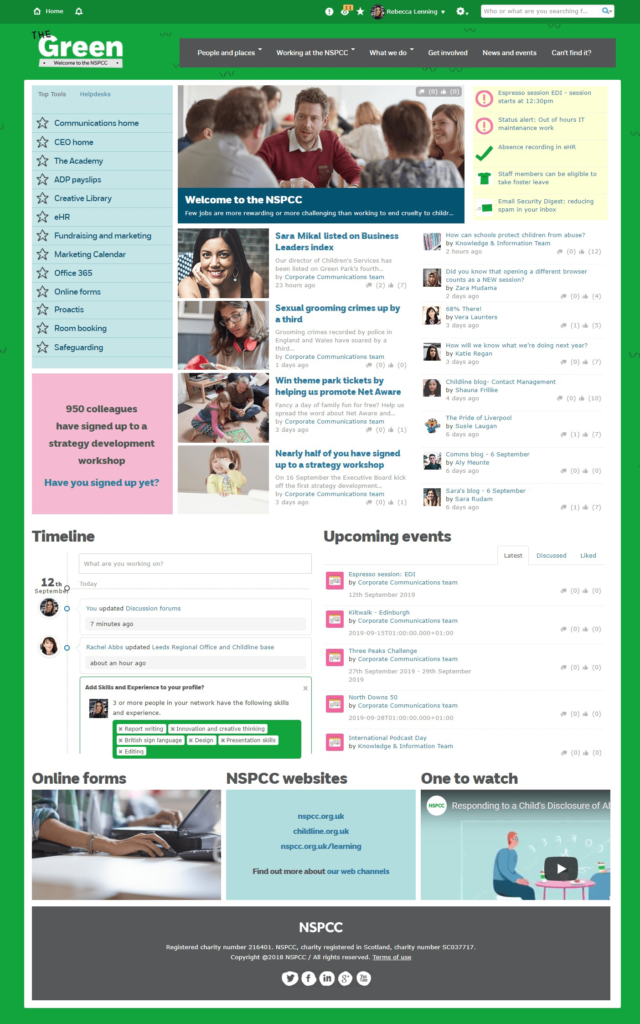
#13: Don’t make it “all business”
The overwhelming success of social media shows how valuable personal, human-centric content is. While your intranet will be the go-to place for business-critical content, communications, and policies, it’s also important to add community content that drives intranet adoption and smooths out the change management process.
Mixing up content formats and introducing informal elements can boost company culture. Ideas include “buy and sell” forums, wedding or baby announcements, hobby-based intranet communities, or personal blogs and updates from employees.
Travelex’s intranet “The Lounge” has become the heart of a global online community.
Everyone, from senior executives through to bureau workers, has a chance to get support and share their stories with a wider audience. Even our CEO contributes regular vlogs and comments on staff posts, engaging with all our users.
We have staff writing about things that go way beyond their day jobs. People are supporting each other through illnesses, divorces, and other challenges—and these are people from all over the world who may never have met each other face to face. They’re also sharing positive stories and experiences, which is helping us to embed a common culture.

#14: Social tools that drive intranet adoption
Implementing a new intranet may be a significant project, so it’s critical to make sure people don’t just know about it: they need to use it too.
Social media functionality, including @mentioning, #hashtagging, image-friendly newsfeeds, forums, commenting, sharing, and gamification options, are all effective ways to get people active in your digital workplace.
The digital-native workforce has such a high degree of experience (and expectation) of these now-familiar tools that not offering them as standard will mean software adoption may be low. If you have a constant flow of news that people want to consume, it is possible that your intranet could be successful with only passive consumption, but a quick look at the comment sections of news websites and video platforms like YouTube suggests that true engagement comes when people get a place to add their opinions.
To continue the momentum gained during the excitement of a rollout, schedule mini-campaigns to encourage employees to post, like, and share their peers’ posts. This gives a boost to contributors and generates important conversations and connections.
Must-Read Intranet Playbook
#15: Introduce employee recognition and rewards
One of the most consistently popular and well-used aspects of Interact’s intranet is the employee recognition program.
Peer-to-peer recognition is 35.7% more likely to have a positive impact on financial results than manager-only recognition.
SHRM
How do these employee recognition ideas work?
Employees give “donuts” to one another from a monthly allowance. These points are awarded to give thanks or recognition for anything ranging from support on a project to resolving a customer issue.
Everyone can redeem accumulated donuts for a range of rewards. And, when individuals attach a company value to their nomination, they enter their peers into consideration for wider recognition within the company.
It’s quick, simple, and plays a huge role in driving morale and embedding our corporate values. It also makes the intranet social and engaging so that people come back and are continually exposed to news and updates when they do.
#16: Personalize internal communication
Do the team in Atlanta need to know that the kitchen is closed in the Dallas office? Will your HR and Finance teams be interested in the number of customer support tickets resolved this quarter? Probably not.
While there are some company-wide updates everyone must see, surplus digital noise is a major deterrent to intranet adoption and a burden on internal comms teams.
This can be reduced by a personalized communication strategy that uses technology to ensure content is always relevant and customized.
Geofencing is one example of this. By setting up a virtual perimeter around specific locations, each time an employee logs on to the intranet within that space, they only see content intended for them. This is extremely effective in cases where individuals move frequently and require different content and documentation across locations (e.g., salespeople or senior leaders on location visits).
This builds value for users and keeps them returning to the intranet platform.
Software adoption as a change management project isn’t a one-off event
Engaging people with an intranet – or any new digital application – isn’t an organizational and behavioral change to tick off once and forget.
To drive enviable intranet usage numbers and get employees to adopt new processes and platforms, you must revisit, evolve, update, and adapt based on user feedback and new realities.
Delve into the analytics. Where are people engaged or not? Which search terms lack any internal content? Conduct focus groups or surveys. Are certain teams or individuals great supporters you could enlist as internal authors?
Technologies and user needs are in a constant state of change. Driving intranet adoption requires a continual approach to change management too.
